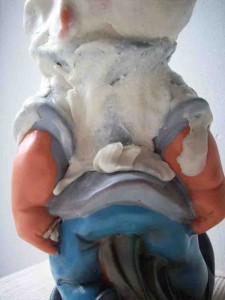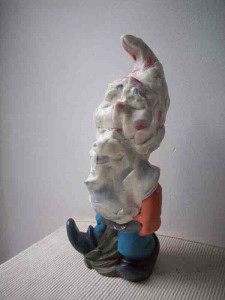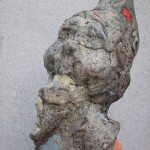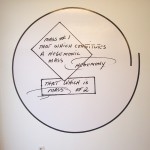Ever seen a sticky gnome? I made an experimental one about a year ago. At…
A sticky gnome and good/bad art criteria

 Being really fed up with the world in general last thursday, and the art world in particular, I decided that I was going to make the worst artwork that I possibly could. I somehow got the idea that a garden gnome full of chewing gum would fit the bill. Pictures on the left show the intermediate result- chewing gum so yukky that I haven’t finished the thing yet.
Being really fed up with the world in general last thursday, and the art world in particular, I decided that I was going to make the worst artwork that I possibly could. I somehow got the idea that a garden gnome full of chewing gum would fit the bill. Pictures on the left show the intermediate result- chewing gum so yukky that I haven’t finished the thing yet.
Now that the pique has passed I thought I could analyse this object to try and formulate my criteria of ‘bad art’, turn them 180 degrees and have more criteria of ‘good’ art. Here goes:
– Gnome is mass produced, ugly;
– Gnome is a tepid echo of the animistic belief that all of nature possesses a spirit;
– Gnome is unresponsive to space/place – its silly smile never disappears, whatever context it is placed in;
– Gnome is culture at its cheapest, worst;
– Gnome invites no participation;
– Gum is yukky, prohibiting touch:
– Form is formless, a blob, but not an interesting blob;
– It is a ‘canonical form’, a statue of sorts.
– It isn’t layered, it doesn’t reference other art, it asks no questions;
In a way I did not succeed – my idea of a bad artwork is a work that exites no curiosity at all. Have to test this, but I think this gnome is not forgettable enough, the question it asks being ‘why is this gnome covered in chewing gum? It may be just as difficult to make bad art as it is making good art.
I had some ideas for criteria written down in an earlier blog. The argument went like this:
If aesthetic criteria are applied to the ‘canonical’ art forms only, and there is a suspension of aethetic criteria for the new forms, and my work is in the category of ‘new forms’ , then what criteria can be applied to my experimental environments?
– the criterium of ‘are they tempting enough to get people to engage with them’ – succes would be measured in the level of participation.
– the criterium that goes with the element of surprise: did particpants leave with a smile on their face?
– the criterium could be effectiveness: ‘did I get my message across’, the message being ‘explore – be here – be now” (see blog ‘manifesto revised’)
The ‘bad art’ exercise suggests the following criteria:
– the criterium of uniqueness: hand-crafted, original
– the criterium of layeredness; of the work being intelligent, referencing other works of art or asking questions about art;
– the criterium of the work being responsive to place;
– the criterium of the work being inviting to the touch; a specific instance of being tempting;
– the criterium of the work having an interesting form; also a specific instance of being tempting;
I notice a somewhat sly return of the aesthetics. Quote from Henk Slager’s ‘Differential Iconography’ chapter 7 ‘Delta Knowledge’: “When Baumgarten introduced the concept of aesthetics in the year of 1750, he spoke of a cognitio sensitiva, a ‘sensuous knowledge’.” I interpret this as meaning that a work of art that fulfills aesthetic criteria is a work of art that is pleasing to the senses. If not pleasing to the senses, the work is not tempting. When not tempting, people do not participate. When no participation, gone is the element of surprise. When no participation, the chance of being effective is effectively zero.
Am I going around in circles with this?
| « Popper, Newton’s apple and dwarves on the shoulders of giants. | <-- previous post | next post --> | A normal/abnormal balance » |
|---|







